Irinotecan in Advanced Lung Cancer: Focus on North American Trials
New agents with improved systemic activity are needed for the treatmentof lung cancer. Irinotecan (Camptosar) is a promising agent inadvanced non–small-cell (NSCLC) and small-cell lung cancer (SCLC).In a Japanese phase III trial of advanced NSCLC, irinotecan oririnotecan/cisplatin demonstrated a significant survival advantage comparedto the standard of vindesine/cisplatin. Similar North Americanphase III trials focusing on irinotecan’s role in NSCLC are under way.Ongoing trials have also been launched to corroborate the significantsurvival advantage reported by a Japanese phase III trial for irinotecan/cisplatin vs standard etoposide/cisplatin in extensive SCLC. Currentand planned trials in NSCLC with irinotecan in combination withgemcitabine (Gemzar), the taxanes, and other new agents, and thoracicradiotherapy should also provide useful clinical data. Moreover,trials in SCLC are investigating the rationale of combining irinotecanwith a platinum agent as a component of chemoradiotherapy regimens.Promising data from these and other studies will further elucidate arole for irinotecan in the management of lung cancer.
ABSTRACT: New agents with improved systemic activity are needed for the treatmentof lung cancer. Irinotecan (Camptosar) is a promising agent inadvanced nonâsmall-cell (NSCLC) and small-cell lung cancer (SCLC).In a Japanese phase III trial of advanced NSCLC, irinotecan oririnotecan/cisplatin demonstrated a significant survival advantage comparedto the standard of vindesine/cisplatin. Similar North Americanphase III trials focusing on irinotecan’s role in NSCLC are under way.Ongoing trials have also been launched to corroborate the significantsurvival advantage reported by a Japanese phase III trial for irinotecan/cisplatin vs standard etoposide/cisplatin in extensive SCLC. Currentand planned trials in NSCLC with irinotecan in combination withgemcitabine (Gemzar), the taxanes, and other new agents, and thoracicradiotherapy should also provide useful clinical data. Moreover,trials in SCLC are investigating the rationale of combining irinotecanwith a platinum agent as a component of chemoradiotherapy regimens.Promising data from these and other studies will further elucidate arole for irinotecan in the management of lung cancer.Lung cancer is diagnosed in morethan 170,000 Americans yearly.Although the mortality rateis starting to plateau in North Americanmales, it continues to rise in Americanwomen and in both gendersoutside the United States, particularlyin Europe and the Orient. The 5-yearsurvival rate in the United States is14%, compared with 8% in the UnitedKingdom.[1,2] The majority ofpatients manifest with disseminateddisease at diagnosis or develop distantmetastases shortly after initial localregional therapy. Hence, newagents with improved systemic activityare desperately needed.This paper will detail ongoing, randomizedphase III trials in NorthAmerica in extensive disease smallcelllung cancer (ED SCLC), whichwill serve to either confirm or refutethe role of irinotecan (Camptosar) establishedby a critical Japanese effort.It will also address the role of irinotecanin combination with platinum upfront in treatment-naive non-small-cell lung cancer (NSCLC) patientsand with nonplatinum agents inboth the first-line and second-line settingin advanced NSCLC. We willdiscuss these trials in the context ofcurrent state-of-the art therapy in bothsettings.Non-Small-Cell Lung CancerSingle-Agent Therapy
Multiple phase II studies, particularlyin Japan, have established theutility of irinotecan in the treatmentof advanced NSCLC (Table 1). Responserates have ranged as high as30% to 35%, using conventionalschedules of irinotecan at doses of100 to 125 mg/m2 weekly 3 or 4,[3-5] or doses of 300 to 350 mg/m2 every3 weeks, with or without hematopoieticgrowth factor support.[6] Toxicitieshave been manageable and havegenerally included myelosuppressionand diarrhea. In the sole US trial evaluatingsingle-agent irinotecan, Bakerand colleagues noted a 15% responserate in 41 patients receiving a dose of100 mg/m2 weekly 4 every 6 weeks;79% had stage IV disease.[7]
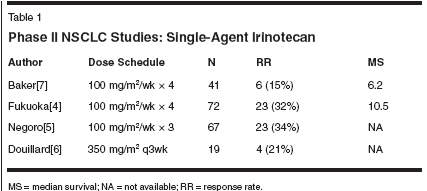
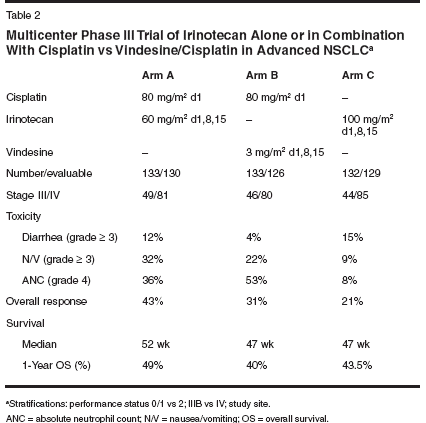
Kamuyama et al (Hokkaido Instituteof Public Health, Sapporo, Japan)examined the activation/detoxification of irinotecan by humanlung cancer cell lines and determinedthe expression of the putativeenzyme(s) that convert irinotecan tothe active moiety, SN-38.[8] Of 25squamous cell carcinoma cell lines,15 were strongly positive for carboxylesterase;of 25 adenocarcinomas, 20were positive, including 4 that expressedstrong positivity.Cisplatin/Irinotecan Combinations
Cisplatin remains the cornerstoneof combination therapy in advancedNSCLC. In preclinical models, cisplatinin combination with irinotecan,has yielded synergistic cytotoxicity.With the exception of myelosuppression,irinotecan and cisplatin havenonoverlapping toxicities. Consequently,investigators have sought toassess the clinical activity of irinotecanin combination with cisplatin. Theearliest efforts emanated from Japan.Masuda and colleagues evaluated cisplatinat 80 mg/m2 on day 1 every 4weeks in combination with irinotecanat 60 mg/m2 on days 1, 8, and 15.[9]The overall response rate was 52%;time to progression was 4.4 months,median survival was 10.2 months, andthe 1-year survival rate was 33%.Ueoka et al assessed the irinotecanand cisplatin combination at doses of50 and 60 mg/m2, respectively, ondays 1 and 8 every 4 weeks.[10] Theoverall response rate was slightly lowerat 41%. Median survival was 13months; the 1-year survival rateproved promising at 58%. Mori et alconducted a phase II study of irinotecanat 160 mg/m2 bolus on day 1 incombination with cisplatin at20 mg/m2 daily 4 by continuousinfusion with granulocyte colonystimulatingfactor (G-CSF) support.[11] Twenty-four treatment-naiveadvanced NSCLC patients were evaluated.The overall response was58.5%, with a median survival time of44.8 weeks and 1-year survival rate of44%. Major adverse events includedgrade 3/4 diarrhea (23% of patients),granulocytopenia (20%), thrombocytopenia(15%), and anemia (15%), withoutany treatment-related deaths.In Europe, Cardenal and colleaguesmounted a multi-institutional phase IItrial combining infusional irinotecanat 200 mg/m2 over 1 hour in combinationwith cisplatin at 80 mg/m2 every21 days.[12] Over an 8-month period,48 patients were recruited; 43 wereevaluable for toxicity. Grade 4 neutropeniaoccurred in 11.6%, grade 4diarrhea in 9.3%, and grade 3 nauseaand vomiting in 16.2%. Of 32 evaluablepatients, 12 (37.5%) achieved apartial response.Phase III Randomized Trials
Two separate prospective, randomizedphase III trials evaluated the roleof irinotecan in advanced NSCLC.Negoro et al compared irinotecan eitheralone or in combination with cis-platin to a vindesine/cisplatin combination.[13] Eligibility stipulatedchemonaive stage IIIB or IV measurableNSCLC, Eastern CooperativeOncology Group (ECOG) performancestatus 0 to 2, and adequatemarrow, hepatic, renal, and pulmonaryfunctions. Patients older than 75years were excluded; 241 patientswere enrolled. Demographics with respectto age, performance status, priorweight loss, albumin, and lactatedehydrogenase were well matched foreach arm.Patients received one of threeregimens (results are delineated inTable 2):
- Arm A:Irinotecan at 60 mg/m2days 1, 8, and 15 and cisplatin at 80mg/m2 on day 1 every 4 weeks (basedon Masuda et al[9] and Negoro etal[13]).
- Arm B: Vindesine at 3 mg/m2 ondays 1, 8, and 15 and cisplatin at 80mg/m2 on day 1 every 4 weeks (thestandard).
- Arm C: Irinotecan at 100 mg/m2on days 1, 8, and 15 every 4 weeks.
Leukopenia was much more pronouncedin the vindesine/cisplatincombination, while thrombocytopeniawas more common in the irinotecanand cisplatin combination. Bothirinotecan arms resulted in substantiallymore grade 3 and 4 diarrhea.The cisplatin arms yielded considerablymore nausea and vomiting. Theincidence of anemia was driven bycisplatin: 39% grade ≤ 3 for irinotecanand cisplatin compared with 23%for vindesine and cisplatin, and 6%for irinotecan alone. Survival amongstage IV patients was significantlybetter for those receiving irinotecan(arm A or C) compared to thosereceiving vindesine and cisplatin(Figure 1).
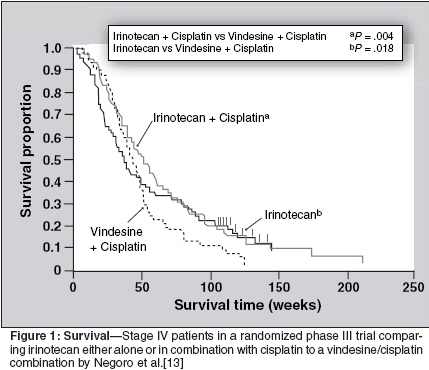
In contrast, a second phase III trialreported by Niho et al[14] and Kunitohand colleagues[15] comparing thetwo platinum combinations alone didnot reveal a significant advantage ordisadvantage for irinotecan. Baselinedemographics were well matched inthe 199 randomized patients. Grade ≥3 neutropenia was more common forthe vindesine and cisplatin arm (83%)compared with the irinotecan and cisplatinarm (64%). Grade ≥ 3 anemiawas more common for the irinotecancombination (24%) compared with thevindesine and cisplatin arm (17%).Likewise, grade ≥ 3 nausea/vomitingand diarrhea were more common at19% and 15%, respectively, for irinotecanand cisplatin, compared with12% and 2%, respectively, for the vindesineand cisplatin combination.Median survival for patients enrolledin the irinotecan and cisplatinarm was 10.6 months, with 1- and 2-year survival rates of 36.4% and 8.7%,respectively, in stage IV patients.Median survival for vindesine andcisplatin was 11.5 months, with 1-and 2-year survival rates of 41.4%and 10.3%, respectively (
P
= .668).Significant negative prognostic factorsincluded male gender (
P
= .0028)and performance status of 2 (vs 0/1)(
P
= .0003).It is unclear why one trial showedan apparent survival advantage for theirinotecan and cisplatin combinationin stage IV patients, while the otherdid not. Nevertheless, irinotecan joinsthe pantheon of other modern agents(vinorelbine, gemcitabine, the taxanes)which, in combination with aplatinum, have demonstrated comparableif not superior activity to oldersecond-generation agents.
North American Trials
The initial combination effort inNorth America reported by DeVoreand colleagues[16] recapitulated theJapanese study of Negoro and colleagues.[13] Cisplatin was dosed at80 mg/m
2
on day 1, and irinotecanat 60 mg/m
2
weekly 3 every 4weeks.[16] A total of 52 patients wereenrolled. Overall response rate was29%, with a median time to progressionof 5.1 months, a median survivalof 9.9 months; and a 1-year survivalof 37%.Grade ≥ 3 neutropenia occurred in46% of patients, with an overall 11.5%incidence of febrile neutropenia. Nauseaand vomiting and asthenia weredriven by cisplatin. The relative grade≥ 3 incidences were 32.7% and 23.1%,respectively. Grade 3 or 4 diarrheaoccurred in 17.3% of patients. Therelative dose intensity of irinotecanwas 75.5%. Dose reductions of irinotecanwere required by 73% of patients.Most patients ultimately hadtheir irinotecan dose reduced to ≤40mg/m
2
weekly. This trial has been criticized for overly stringent dose modificationcriteria.

Consequently, a follow-up studymounted through Vanderbilt CancerNetwork (VCCAN) and Fox ChaseCancer Center (FCCC) combinedweekly irinotecan with weekly cisplatin.[17] There were three justificationsfor this move: (1) same-dayadministration could better exploit theputative in vitro synergy of these twoagents; (2) improved sequencing ofirinotecan and cisplatin might potentiallyimprove efficacy; and (3) decreasingthe cisplatin dose peradministration could potentially diminishtoxicity. The regimen wasmodeled after phase I data of Saltzand colleagues.[18] Eligible patientsreceived irinotecan at 65 mg/m
2
weekly 4 in combination with cisplatin at30 mg/m
2
weekly 4. Treatment wasrepeated at 6-week intervals. A totalof 50 patients were enrolled.Overall response rate was 36%;median time to progression was 6.9months, median survival was 11.6months, and 1-year survival was 46%.These results were the best ever observedin advanced NSCLC in thehistory of the VCCAN, and provedcomparable to previous results seenwith combination paclitaxel and carboplatin(Paraplatin) at FCCC and itsaffiliated network. The overall incidenceof grade ≥ 3 neutropenia was25.5%; febrile neutropenia occurredin 6% of patients. Grade ≥ 3 thrombocytopeniaoccurred in 12% and grade≥ 3 nausea and vomiting in 26% ofpatients. The relative dose intensityof irinotecan in this combination was89%, and the dose intensity was fairlywell maintained for both agents.Comparison of the two NorthAmerican irinotecan and cisplatin regimensis depicted in Table 3. Data todate favor using weekly as opposedto monthly cisplatin. Nausea and vomitingwere less pronounced. In addition,serious neutropenia was lesscommon. Finally, the response rateand survival appeared comparable to,if not superior to, the standard establishedapproach using monthly cisplatinand weekly irinotecan. Becauseof cumulative asthenia, several investigatorshave proposed a 2-weeks-on/1-week-off schedule, although thisapproach has never been formallystudied. Interest also exists in comparingthis schedule to other establishedcytotoxic regimens, thoughplanned trials have not yet evolved.Compared to cisplatin, carboplatinyields considerably less nonhematologictoxicity, in particular nausea andvomiting. Fledgling phase I Japaneseefforts have integrated carboplatin andirinotecan. In one effort, 17 patients,71% of whom had stage IV NSCLC,received carboplatin at area under theconcentration-time curve (AUC) of 5every 4 weeks and irinotecan weeklyon days 1, 8, and 15 every 4 weeks.The maximum tolerated dose of irinotecanwas 60 mg/m
2
and the recommendedphase II dose was 50 mg/m
2
.Dose-limiting toxicity included neutropeniaand thrombocytopenia. Mediansurvival was 10.5 months; 1-yearsurvival was 35%.[19]Mukohara and colleagues evaluateda similar regimen.[20] The incidenceof grade ≥ 3 neutropenia,anemia, thrombocytopenia, and diarrheawas 76%, 26%, 47%, and 6%,respectively. Only 43% of the intendedday 15 irinotecan dose was administered.Overall response rate was25%. Median survival was 10.8months and 1-year survival was39%.[20]Sunpaweravong et al[21] at theUniversity of Colorado evaluated thiscombination further. A total of 14 patientswere enrolled onto this phase I/II effort, including 10 with NSCLCand 2 with SCLC. The initial dose ofcarboplatin at AUC 6 and irinotecanat 60 mg/m
2
days 1 and 8 every 3weeks proved too toxic. DLT includedneutropenia, thrombocytopenia,diarrhea, and fatigue; hence the recommendeddose was AUC 5 for carboplatinand 50 mg/m
2
days 1 and 8for irinotecan. Partial responses wereobserved in one patient each withNSCLC and SCLC, and stable diseaseoccurred in two patients(NSCLC). A phase II trial by Kellyand colleagues at this institution inuntreated extensive-stage SCLC isunder way.
Taxane and IrinotecanCombinations
There are a number of reasons toconsider irinotecan and taxanes incombination. Each is individually activein both NSCLC and SCLC. Bothagents have nonoverlapping toxicities,malleable schedules, and relative non-cross resistance. Finally, preclinicaldata suggest an additive, if not synergistic,effect. Murren and colleaguesmounted a phase I trial of irinotecanand paclitaxel, both agents administeredweekly 4 every 6 weeks.[22]Twenty-one patients were enrolled inthis phase I study. A total of 53 cycleswere administered. The maximum tolerateddose for irinotecan in thisschedule was 50 mg/m
2
and paclitaxel75 mg/m
2
weekly. Pharmacokineticsrevealed no drug-drug interactionbased on levels of irinotecan and itsactive metabolite SN-38. However,chemotherapy on weeks 3 and 4 wasoften dose-modified or omitted. Only26% of cycles were administered asplanned.An ongoing phase II trial by theseinvestigators enrolling advancedNSCLC patients (performance status0 to 2) was an abbreviated schedule:irinotecan at 50 mg/m
2
weekly 2every 3 weeks in combination withpaclitaxel at 75 mg/m
2
weekly 2every 3 weeks. To date, 10 patients,ages 47 to 68, have been accrued.There has been no grade 4 neutropenia.The relative dose intensity is 97%.Two of six evaluable patients havesustained partial response (18+weeks), three have had stable disease,and one only progressive disease.Rosen et al combined irinotecanwith paclitaxel, both agents given onceevery 3 weeks.[23] The maximumtolerated doses were 225 and100 mg/m
2
, respectively. Grade ≥3diarrhea was observed in only one ofnine treatment courses at maximumtolerated dose, whereas at higher doses,grade ≥ 3 diarrhea occurred in fiveof seven patients. Objective responseswere seen in NSCLC and in occultprimary squamous malignancy. As inthe Murren trial, paclitaxel coadministrationdid not alter irinotecan pharmacokinetics(irinotecan and SN-38levels).Socinski and colleagues havemounted phase I and phase II studiesof irinotecan in combination with standardpaclitaxel and carboplatin.[24]Thirty-three NSCLC patients wereenrolled in the initial phase I effort.The maximum tolerated doses forthese three agents using an every-3-week schedule were paclitaxel at 175mg/m
2
on day 1, irinotecan at 100mg/m
2
on day 1, and carboplatin atAUC 5 on day 1. Myelosuppressionprecluded more frequent weekly dosingof irinotecan.The overall response rate was 39%(10% complete response). Mediantime to progression was 6.8 months;median survival was 11 months, and1-year survival was 46%. Forty patientswere ultimately enrolled in thesubsequent phase II effort using themaximum tolerated doses establishedin the phase I trial. The response rateof 32% proved comparable to thephase I effort. Time to progression at5.6 months was similar; median survivalexceeded 1 year.[25] The incidenceof neutropenic fever, significantfatigue, and late diarrhea was 20%each.Based on these promising results,a randomized phase II study in fitstage IIIB/IV NSCLC patients assessingthe triple-agent regimen and itsconstituent double-agent regimens(irinotecan and carboplatin and paclitaxeland irinotecan) using a 1:1:1assignment was initiated. Unfortunately,because of sluggish accrual, thistrial was shelved.Phase I trials have also assessedirinotecan in combination with docetaxel(Taxotere).[26] Thirty-two treatment-naive advanced NSCLC patients(22 stage IV) received docetaxel onday 2 and irinotecan on days 1, 8, and15. Eligibility stipulated ECOG performancestatus 0 to 2, ≤ 75 years ofage, and adequate marrow, hepatic,and renal function. Median age was55 years (range: 46 to 71 years); 17were male. Doses were escalatedacross sequential cohorts. The maximumtolerated dose for each agentwas 50 mg/m
2
. Higher doses led todose-limiting toxicity, primarily neutropenia.The overall response rate was37%, median survival was 48 weeks,and 1-year survival was 45%. Therewas no effect of irinotecan on docetaxelpharmacokinetics.Murren and colleagues evaluatedweekly therapy using both agents.[27]Cohort A received weekly therapy 4 every 6 weeks; cohort B receivedweekly therapy 2 every 3 weeks. Atotal of 44 patients were accrued; 26were previously treated with chemotherapy;20 were diagnosed withNSCLC, 12 with pancreatic and biliaryprimaries, and 14 with other diagnoses.Seventy-five percent weremale. All but seven were performancestatus 0 or 1. The maximum tolerateddoses for irinotecan and docetaxelusing the weekly 4 regimen were50 and 35 mg/m
2
, respectively. Themaximum tolerated doses for theweekly 2 regimen were 60 and 35mg/m
2
, respectively.[25] From thestandpoint of cumulative toxicity anddose intensity, the latter schedule wasconsidered preferable.Adjei and colleagues[28] adoptedan opposite tactic, dosing each agentat 3-week intervals. Irinotecan wasescalated from 160 to 200 mg/m
2
, anddocetaxel from 50 to 75 mg/m
2
Eighteenpatients were accrued, and 85courses were administered. Dose-limitingtoxicity proved to be myelosuppression;neutropenic fever occurredin three individuals. Diarrhea wasdose-dependent, but severe only inthose who neglected to take appropriateantidiarrheals. Nonhematologictoxicity was mild to moderate withgrade 3 anorexia and nausea observedin one patient each. Five of 16 patientsresponded, including three withNSCLC and one each with soft tissuesarcoma and cholangiocarcinoma.The maximum tolerated doses and recommendedphase II doses for irinotecanand docetaxel were 160 and65 mg/m
2
, respectively.[28]
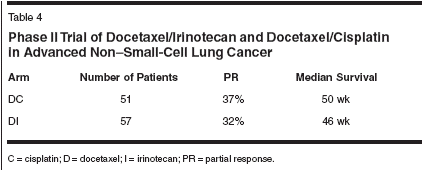
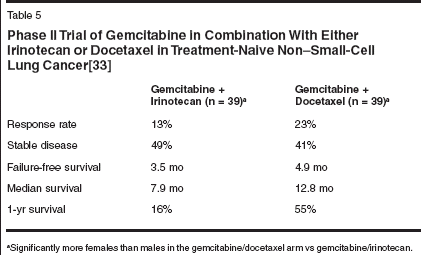
In a critical randomized phase IIstudy conducted in Japan, this combinationof docetaxel and irinotecan appearedequivalent to docetaxel andcisplatin[29] in the therapy of advancedNSCLC (Table 4). Treatmentwas cycled at 3-week intervals; patientsreceived a fixed dose of docetaxel60 mg/m
2
and were randomized toeither cisplatin at 80 mg/m
2
or to irinotecan at 60 mg/m
2
on days 1 and 8.
Irinotecan and Gemcitabine
Both gemcitabine and irinotecanhave nonoverlapping toxicity profilesand are individually active in NSCLCand SCLC. In addition, Bahadori etal[30,31] demonstrated preclinicalsynergy in SCLC cell lines. Rocha-Lima and colleagues[32] completed aphase I trial of irinotecan in combinacombinationwith gemcitabine and showed thatboth agents could be combined atnearly full dose.The Cancer and Leukemia GroupB (CALGB) recently completed accrualto a randomized phase II trial ofgemcitabine (Gemzar) in combinationwith either irinotecan (GI) or docetaxel(GD) in advanced NSCLC.[33]In the GI arm, irinotecan was dosed at100 mg/m
2
and gemcitabine at 1,000mg/m
2
, each agent given on days 1and 8 every 3 weeks. In the GD arm,the relative doses were 1,000 mg/m
2
and 40 mg/m
2
on days 1 and 8 every 3weeks. Results are shown in Table 5.Although the response and survivalrates ostensibly appear lower in theGI arm, significantly fewer women(28%) were entered onto that armcompared to the GD arm (54%). TheCALGB has almost completed a sal-vage trial in both chemosensitive andchemorefractory progressive SCLCusing an identical GI regimen.A trial presented at the 2002 AmericanSociety of Clinical Oncology annualmeeting evaluated irinotecaneither alone or in combination withgemcitabine in the second-line setting.[34] In the single-agent arm, irinotecanwas dosed at 300 mg/m
2
every3 weeks; an identical dose was givenon day 8 in combination with gemcitabineat 1,000 mg/m
2
on days 1 and 8.More than 130 patients were enrolled.The combination regimen yielded asignificantly better response rate: 21%vs 6% (
P
= .015); but it also inducedsignificantly more anemia (
P
= .017).There was no difference in the incidenceof neutropenia, thrombocytopenia,or diarrhea. Median survival forthe combination arm was 9 monthscompared with 8 months for the single-agent arm.Pectasides et al[35] and Tsavariset al[36] reported on very similar trialsevaluating combination gemcitabineand irinotecan in NSCLC patientspretreated with platinum. Both studiesemployed an identical dose of gemcitabineat 1,500 mg/m
2
days 1 and 15every 4 weeks. In the Pectasides trial,[35] irinotecan was dosed at 150mg/m
2
every 2 weeks, while in theTsavaris trial,[36] irinotecan wasdosed at 180 mg/m
2
every 2 weeks(Table 6).At the 2003 World Conference onLung Cancer (WCLC) meeting inVancouver, British Columbia, Lilenbaumand colleagues[37,38] summarizedthe preliminary results of arandomized phase II trial in pretreatedNSCLC patients evaluating irinotecanin combination with eithergemcitabine (GI) or docetaxel (DI),with or without celecoxib (Celebrex).This trial used a 2 * 2 factorial design,allowed one prior chemotherapeuticregimen, and excludedpatients with performance status 2.Irinotecan was dosed at 100 mg/m
2
on days 1 and 8 in the GI arm incombination with full-dose gemcitabineat 1,000 mg/m
2
on days 1 and8. In the DI arm, irinotecan was dosedat 65 mg/m
2
on days 1 and 8 in combinationwith docetaxel at 35 mg/m
2
on days 1 and 8. The primary endpoint was 1-year survival; secondaryend points included response rate, timeto progression, and quality of life.As of August 2003, 133 patientshad been accrued. In an interim assessmentof toxicity, the GI regimenresulted in more thrombocytopenia(34% vs 0%) and febrile neutropenia(6% vs 0%), while the DI regimencaused more diarrhea (28% vs 13%).There was no obvious exacerbationof toxicity by celecoxib. Pulmonaryadverse event rates hovered at 20%for both regimens, but attribution (diseasevs toxicity) has not yet beenworked out. Using strict ResponseEvaluation Criteria in Solid Tumors(RECIST) criteria, the response ratesthus far are relatively low: 4% for DIand 8.6% for GI. Celecoxib neitheradded to nor detracted from the activityof the cytotoxics. These resultsare in keeping with the results observedfor docetaxel alone in randomizedphase III trials. Overall survival,time to progression, and quality-oflifedata are not yet available.
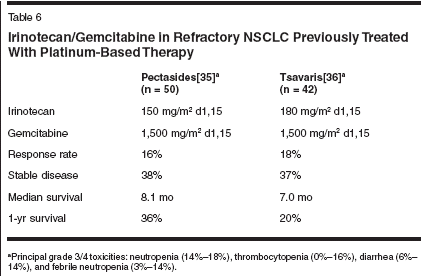
Future Efforts inAdvanced Disease
The Southwest Oncology Group(SWOG) has mounted a phase II studyassessing the combination of irinotecanand gemcitabine in treatmentnaiveSCLC. A phase III trialcomparing cisplatin and irinotecanusing a day 1, day 8 schedule every 3weeks to irinotecan/gemcitabine andgemcitabine/cisplatin is being consideredin NSCLC. In addition, aphase III study of weekly cisplatinand irinotecan * 4 every 6 weekscompared to standard therapy is contemplated,as are phase I and II effortsintegrating angiogenesisinhibitors and COX-2 inhibitors (celecoxib)with this regimen.Finally, the Japanese are spearheadinga four-arm phase III randomizedtrial comparing irinotecan andcisplatin, their new standard, to otherstate-of-the-art combinations, includingvinorelbine (Navelbine) and cisplatin,gemcitabine and cisplatin, andcarboplatin and paclitaxel.In summary, a survival advantagehas been observed in stage IV patientsin at least one trial using monthlycisplatin and weekly irinotecan comparedto the combination of vindesineand cisplatin. However, the combinationof weekly irinotecan and cisplatinappears to be more active and bettertolerated. Future randomized studieswill elucidate the status of irinotecancombinations vis--vis other standardcombinations, especially as salvagetherapy in chemoexposed patients. Forexample, a phase III trial randomizingchemoexposed NSCLC patientsin a 2:1 ratio to either docetaxel at 60mg/m
2
on day 1 and irinotecan 60mg/m
2
on days 1 and 8 or singleagentdocetaxel at 75 mg/m
2
has beenproposed, with a study design incorporatingresponse rate as the primaryobjective (target 22% vs control 10%).It remains to be seen if this type oftrial will be initiated.

Small-Cell Lung Cancer
Phase II studies have indicated thatirinotecan is both a promising singleagent[39-42] and combination partnerwith cisplatin in the treatment ofadvanced small cell malignancy (Table7). Kudoh et al[43] reported anoverall response rate of 84% for thiscombination. Complete response ratewas 29%; median survival in thosewith extensive disease was promisingat 13.2 months with a 2-year survivalof 17%Nakamura and colleagues conducteda phase II trial of irinotecan andetoposide based on the rationale ofreports of preclinical synergy for topoisomeraseI and topoisomerase IIinhibitors.[44] Chemonaive SCLC pa-tients (n = 51; 94% performance status0/1) received irinotecan at 60 mg/m
2
days 1, 8, and 15 with etoposide at80 mg/m
2
days 2, 3, and 4. The responserate was 66%, with completeresponses in 10% of patients. Mediansurvival time was 12 months. Grade ≥3 toxicities were uncommon, with theexception of neutropenia (72%).
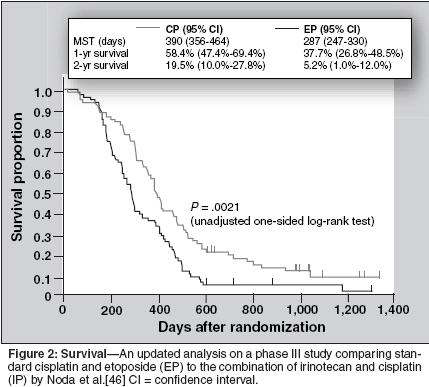
In the relapse setting, irinotecanhas activity comparable to topotecan(Hycamtin). In a US study, DeVoreet al treated 44 chemoexposed patientswith full-dose irinotecan at125 mg/m
2
weekly x 4 every 6weeks.[45] Grade ≥ 3 diarrhea andneutropenia (27% each) were the primaryadverse events reported. Seventeenpatients with chemosensitiverelapse had a response rate of 35%,median time to progression of 3.4months, and median survival of 5.9months vs 3.7%, 1.3 months, and 2.8months, respectively, for 27 patientswith refractory disease.Based on the observation of Kudohand colleagues,[43] Noda et al[46]of Japan conducted a phase III studycomparing standard cisplatin and etoposide(EP) (cisplatin at 80 mg/m
2
onday 1 and etoposide at 100 mg/m
2
ondays 1 to 3, every 3 weeks) to irinotecanand cisplatin combination (IP),the experimental regimen (cisplatinat 60 mg/m
2
on day 1 every 4 weeksand irinotecan at 60 mg/m
2
on days 1,8, and 15 every 4 weeks). Stratificationsincluded performance status andinstitution. Patients whose tumors progressedwere taken off study. Thosewith partial response were observed;and those with complete response ornear complete response were ultimatelyrandomized secondarily to eitherobservation or to radical thoracic radiationtherapy (50 Gy/2 Gy/d x 5weeks). This component of the trialwas later abandoned.Eligibility stipulated cytologicallyor histologically proven SCLC; extensivedisease; no prior radiotherapy,chemotherapy or surgery; ECOGperformance status 0 to 2; age ≤70;and adequate physiologic indices (normalmarrow, liver, and kidney functions).Each arm was fairly wellmatched with respect to demographics.Median age was 63 (range: 30 to70 years). Seventy-seven patients wereaccrued to each arm; all but six in theIP arm and all but 10 in the EP armhad metastatic involvement. Six IPpatients and 10 EP patients were performancestatus 2. Nine patients inthe IP arm and 17 patients in the EParm had a history of brain metastases.The vast majority of patients weremale.This study originally targeted anaccrual of 230 patients, but was suspendedin December 1998 after 154patients were accrued because of ahighly significant difference in survival.In the first analysis, the mediansurvival for IP was 14 months vs 10months for EP. An updated analysis(Figure 2) revealed a median survivalof 390 days for the IP arm comparedwith 287 days for the EP arm, with 1-and 2-year survival rates, respectively,of 58.4% and 19.5% for IP vs37.7% and 5.2% for EP (
P
= .0021).This difference could not be attributedto an imbalance in treatment delivery:69% of those receiving IPtolerated all four cycles compared with71% of those receiving EP. The EPregimen yielded a considerably higherincidence of grade ≥ 3 neutropenia(92% vs 66%,
P
= .0002), and grade≥ 3 thrombocytopenia (18% vs 5%,
P
= .01). Not surprisingly, the IP armcaused substantially more grade ≥ 3diarrhea (16% vs 0%,
P
= .0001). Theoverall response rates were 83% and67%, respectively (
P
= .013).The IP combination has becomethe standard of comparison in Japanfor future studies in extensive disease.Two separate North Americantrials are ongoing. One, initiated bythe SWOG and now open to the Intergroupthrough the Cancer Trials SupportUnit (CTSU), replicates theJapanese effort in terms of dose andschedule. This effort has accrued over150 patients as of April 2004; morethan 600 individuals are targeted foraccrual.The other trial, sponsored by PfizerOncology, compares etoposide at100 mg/m
2
daily x 3 and cisplatin at80 mg/m
2
on day 1 to irinotecan at 65mg/m
2
on days 1 and 8 and cisplatinat 30 mg/m
2
on days 1 and 8 every 3weeks. The trial completed accrual inJune 2003, with more than 330 patientsenrolled.The rationale for this schedule isfourfold: (1) elimination of day 15irinotecan dosing, which was oftenomitted or dose-reduced in the Japanesetrial because of toxicity; (2) symmetrical3-week schedules for botharms; (3) reduced dose of cisplatinper administration in an effort to reducetoxicity; and (4) exploitation ofputative cisplatin-irinotecan synergyusing a weekly combination schedule.The study uses a 2:1 IP vs EPrandomization and targets a 50%1-year and 15% 2-year survival ratefor the IP arm vs 37.5% and 7.5%,respectively, for the control arm. Unlikethe Japanese efforts, there are noage restrictions and no prohibitionagainst prior radiation therapy. Sandlerand colleagues[47] reported thepreliminary results of the phase IIIeffort at the recent WCLC meeting,focusing on toxicity and relative doseintensity of the constituent singleagents.Although performance status 2 patientswere initially enrolled, their recruitmentwas later suspended becauseof concerns regarding untoward toxicity.The baseline demographics forthe first 299 enrolled are well-balancedfor each arm of the study (Table8). Preliminary results showreasonably good tolerance. The relativedose intensity for those receivingcisplatin on the IP regimen was 89.6%vs 91.5% in the EP regimen. The relativedose intensity for irinotecan onthe experimental regimen was 88.7%,while that for etoposide on the standardregimen was 92.6%. (Table 9summarizes the median dose and relativedose intensities in the NorthAmerican and Japanese trials.)As expected, the IP regimen resultedin significantly more grade 3diarrhea and nausea and vomiting,while the EP regimen yielded significantlymore neutropenia and thrombocytopenia.Compared to the toxicityresults observed for those on the IParm in the original Japanese trial, theincidence of neutropenia and anemiafor those enrolled in the experimentalarm in the North American trial wassubstantially lower. The toxicity resultsfor the North American trial areenumerated in Table 10 with clinicallysignificant differences highlighted.Nonhematologic differences are illustratedin Figure 3. Response, progression,and survival results should beavailable at the end of 2004.
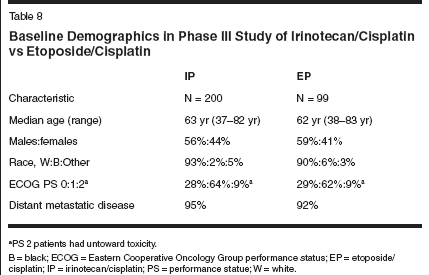
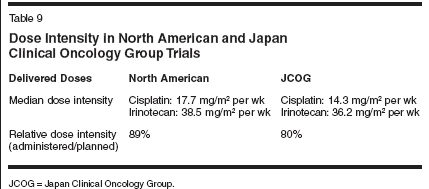
Limited Experience inLimited-Disease SCLC
Unfortunately, investigators havebeen slow to integrate irinotecan intothe concurrent chemoradiation paradigmin limited disease (LD). Kinoshitaand colleagues[48] conducted aphase I study of first-line irinotecanand cisplatin with concurrent thoracicradiation therapy in patients with LDSCLC. Irinotecan was administeredon days 1, 8, and 15 of every 28-daycycle and escalated from 40 to60 mg/m
2
; cisplatin was administeredat a dose of 60 mg/m
2
on day 1 ofeach cycle. Thoracic radiation therapywas given at a dose of 2 Gy dailyduring day 2 of each cycle for 2 consecutiveweeks and then 2 weeks off.Sixteen patients were enrolled. Theoverall response rate was 94%, including25% complete responses. TheMTD of irinotecan in this schedulewas 50 mg/m
2
. Fatigue proved doselimiting. This study, however, did notevaluate the role of irinotecan in combinationwith continuous, uninterruptedradiation therapy in LD.Mori and colleagues also attemptedto insert promising new agents suchas irinotecan into the LD treatmentparadigm.[49] Over a 10-month period,31 patients received standard concurrentRT (45 Gy), cisplatin at 80mg/m
2
on day 1, and etoposide at 100mg/m
2
on days 1, 2, and 3, followedby three cycles of irinotecan at60 mg/m
2
on days 1, 8, and 15, andcisplatin at 60 mg/m
2
on day 1, cycledat 4-week intervals. In this manner,irinotecan was substituted for etoposidein the three cycles following definitiveconcurrent chemoradiation.This trial had no age restrictions. Therewere no treatment-related deaths.The 1-year survival rate provedpromising at 79.3%, and was 87.5%in those completing the IP regimen.Of note, however, only 17 of 30 patientswere able to complete all threecycles. Six patients declined to completetreatment, and six were takenoff treatment because of toxicity. Onlyone patient had progressive disease.Of the two local recurrences to date,both occurred in combination with distantrecurrence. Seventeen additionalpatients experienced distant recurrencealone; 10 were in the brain.Based on the results observed by Moriand colleagues,[49] the Japan ClinicalOncology Group (JCOG) has initiateda phase III study comparingthis regimen to conventional EP/radiationtherapy.
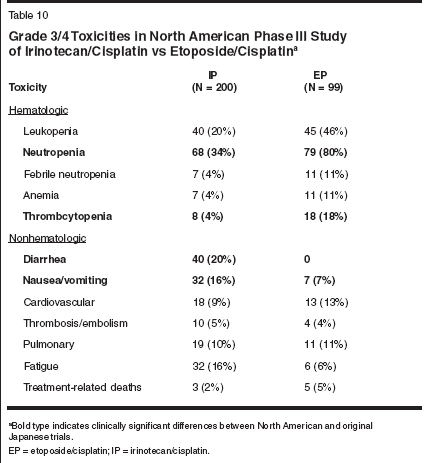
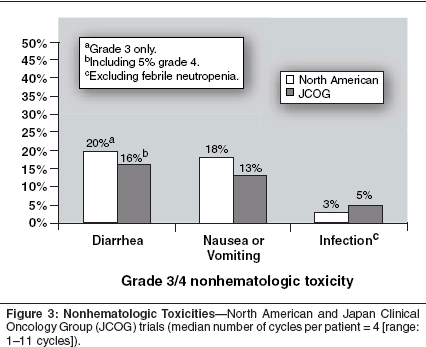
Finally, an Intergroup consortiumspearheaded by the Radiation TherapyOncology Group (RTOG) has proceededwith a randomized phase Istudy of concurrent chemoradiationwith irinotecan and cisplatin at either45 Gy (twice daily) or 70 Gy (oncedaily) followed by irinotecan and cisplatinin LD SCLC. The cisplatin doseis fixed at 60 mg/m
2
every 3 weeks.The irinotecan dose, if feasible, willbe escalated from 40 mg/m
2
on days 1and 8 every 3 weeks to 60 mg/m
2
ondays 1 and 8 every 3 weeks. Onceaccrual to sequence I (45 Gy twicedaily) has been completed, accrual tosequence II using daily 63 to 70 Gydose will begin. In this manner, doselimitingtoxicity will be identified separatelyfor each radiation schema andwe will avoid, if possible, unnecessaryprotocol suspensions while weassess toxicity. This "ping-pong" concepthas already been piloted by theRTOG in the context of locally ad-vanced NSCLC, in which patientsreceiving full-dose radiation therapyreceive gemcitabine in combinationwith either weekly carboplatin orweekly paclitaxel across escalatingdose levels. To date, 20 patients havebeen accrued to the phase I study evaluatingirinotecan and cisplatin in combinationwith either twice daily or oncedaily radiation therapy in limited-stageSCLC.Irinotecan may also have a role asconsolidation therapy in LD SCLC.Saito and colleagues[50] have evaluatedetoposide and cisplatin in combinationwith radiation therapy,followed by either irinotecan and cisplatin(IP) alone or IP combined withetoposide (IPE). In the latter arm,etoposide was given at a dose of50 mg/m
2
on days 2, 3, and 4 of everycycle. However, this three-drug combinationproved unsafe, with onlythree of nine patients completing allthree cycles of IPE after chemoradiation,compared to seven of nine onthe IP arm. Overall response rates wereno different, although neutropenia wassubstantially worse for the IPE combination(92%). In addition, amongthose receiving the three-drug combinationthere was one toxic death fromneutropenic sepsis and diarrhea. Theinvestigators concluded that the threedrugregimen of the consolidation settingwas not feasible becauseunacceptable toxicity.
Conclusion
Irinotecan is a promising agent inthe treatment of advanced NSCLC andSCLC. Ongoing trials have been inauguratedto confirm or refute thesurvival advantage observed for irinotecanin combination with cisplatin inED SCLC. One of two trials has alreadydemonstrated in subanalysis asignificant survival advantage in Japanfor irinotecan and cisplatin comparedto standard treatment in NSCLC.To date, however, phase III trials focusingon irinotecan's role in NSCLCin North America have not yet beenconducted. Over the next 2 to 3 years,considerably more data will be availableregarding this agent, identifyingits ultimate role, and comparing it directlyto other modern agents, includ-ing paclitaxel, gemcitabine, and vinorelbine.Finally, the role of thisagent, either alone or paired with platinum,in combination with standardradiation therapy in the treatment ofLD NSCLC needs to be exploredfurther.
Disclosures:
Dr. Langer has receivedresearch support from and has servedon advisory boards for Pfizer.
References:
1.
Parkin DM, Pisani P, Ferlay J: GlobalCancer Statistics. CA Cancer J Clin 49:33-64,1999.
2.
Maguire J, Kelly V: Sub-optimal treatmentis a contributory factor to poor UK survivalrates in non-small cell lung cancer (abstract1197). Proc Am Soc Clin Oncol 21:300a, 2002.
3.
Fukuoka M, Masuda N: Clinical studiesof irinotecan alone and in combination withcisplatin. Cancer Chemother Pharmacol34(suppl):S105-S111, 1994.
4.
Fukuoka M, Niitani H, Suzuki A, et al: Aphase II study of CPT-11, a new derivative ofcamptothecin for previously untreated nonsmallcell lung cancer. J Clin Oncol 10:16-20,1992.
5.
Negoro S, Fukuoka M, Masuda N, et al:A phase I study of weekly intravenous infusionsof CPT-11, a new derivative ofcamptothecin in the treatment of non-small celllung cancer. J Natl Cancer Inst 83:1164-1168,1991.
6.
Douillard JY, Ibrahim N, Riviere A, et al:A phase II study of CPT-11 in non-small celllung cancer (abstract 1118). Proc Am Soc ClinOncol 14:365, 1995.
7.
Baker L, Khan R, Lynch T, et al: Phase IIstudy of irinotecan (CPT-11) in advanced nonsmallcell lung cancer (NSCLC) (abstract1658). Proc Am Soc Clin Oncol 18:461a, 1997.
8.
Kameyama M, Noainoue S, Ohtsuka K,et al: Activation and detoxification of CPT-11by human lung cancer cells (abstract 1975).Proc Am Soc Clin Oncol 19:2000.
9.
Masuda N, Fukuoka M, Fujita A, et al: Aphase II trial of combination of CPT-11 andcisplatin for advanced non-small cell lung cancer.Br J Cancer 78(2):251-256, 1998.
10.
Ueoka H, Kiura K, Hireki S, et al: Fractionatedadministration of cisplatin andirinotecan in patients with stage IIIB and IVnon-small cell lung cancer: A phase II study(abstract 2026). Proc Am Soc Clin Oncol18:525a, 1999.
11.
Mori K, Machida S, Yo T, et al: A phaseII study of irinotecan and infusional cisplatinwith recombinant human granulocyte: A stimulatingfactor support for advanced non-smallcell lung cancer. Eur J Cancer 35(suppl 4):261,1999.
12.
Cardenal F, Domine M, Massuti B, etal: A phase II multi-institutional study ofirinotecan and cisplatin on a three week schedulein patients with advanced non-small celllung cancer (abstract 1028). Eur J Cancer35(4):S259, 1999
13.
Negoro S, Masuda N, Takada Y, et al:Randomised phase III trial of irinotecan combinedwith cisplatin for advanced non-smallcelllung cancer. Br J Cancer 88:335-341, 2003.
14.
Niho S, Nagao K, Nishiwaki Y, et al: Arandomized multicenter phase III trial ofirinotecan and cisplatin vs cisplatin andvindesine in patients with advanced non-smallcell lung cancer (abstract 1897). Proc Am SocClin Oncol 18:492a, 1999.
15.
Kunitoh H, Saijo N, Nagao K, et al:Cisplatin (CDDP) and irinotecan (CPT-11) versusCDDP and vindesine (VDS) in advanced(stager IIIB and stage IV) non-small cell lungcancer (NSCLC). A multicenter phase III study(abstract 989). Eur J Cancer 35(suppl 4):S249,1999.
16.
DeVore RF, Johnson DH, Crawford J, etal: A phase II study of irinotecan plus cisplatinin patients with advanced non-small cell lungcancer. J Clin Oncol 17:2710-2720, 1999.
17.
Jagasia, M, Langer C, Yunis F, et al: Preliminaryresults of a multicenter phase II trialof weekly cisplatin and irinotecan in patientswith advanced non-small cell lung cancer(NSCLC): A Vanderbilt Cancer Center affiliatenetwork study (abstract 1967). Proc Am SocClin Oncol 18:510a, 1999.
18.
Saltz LB, Spriggs D, Schaaf LJ, et al: Aphase I clinical and pharmacologic study ofweekly cisplatin combined with weeklyirinotecan in patients with advanced solid tumors.J Clin Oncol 16(12):3858-3865, 1998.
19.
Takeda K, Negoro S, Takifuji N, et al:Dose escalation study of irinotecan combinedwith carboplatin for advanced non-small-celllung cancer. Cancer Chemother Pharmacol48:104-108, 2001.
20.
Mukohara T, Takeda K, Miyazaki M, etal: Phase II study of irinotecan (CPT-11) andcarboplatin (CBDCA) in advanced non-smallcelllung cancer (NSCLC) (abstract 2101). ProcAm Soc Clin Oncol 19:534a, 2000.
21.
Sunpaweravong P, Holden S, Ratts V, etal: A University of Colorado phase I trial ofirinotecan (CPT-11) and carboplatin in advancedlung cancer (abstract 2642). Proc AmSoc Clin Oncol 22:657, 2003.
22.
Murren JK, Peccerillo K, Di Stario SA,et al: Dose escalation and pharmacokineticstudy of irinotecan in combination withpaclitaxel in patients with advanced cancer.Cancer Chemother Pharmacol 46:43-50, 2000.
23.
Rosen P, Schaaf LJ, Knuth DW, et al:Phase I pharmacokinetic trial of irinotecan andpaclitaxel in patients with advanced cancers(abstract 679). Proc Am Soc Clin Oncol18:177a, 1999.
24.
Socinski MA, Sandler AB, Miller LL, etal: Phase I trial of the combination ofirinotecan, paclitaxel, and carboplatin in patientswith advanced non-small-cell lung cancer.J Clin Oncol 19:1078-1087, 2001.
25.
Sandler AB, Socinski MA, Israel VP, etal: Phase II trial of irinotecan, paclitaxel andcarboplatin in advanced or metastatic NSCLC(abstract 1323). Proc Am Soc Clin Oncol20:332a, 2001.
26.
Kudoh S, Negoro S, Masuda T, et al:Phase I/II study of docetaxel and irinotecan forpreviously untreated advanced NSCLC (abstract1891). Proc Am Soc Clin Oncol 17, 1998.
27.
Murren J, Guimaraes RC, Aragao BC,et al: Rationale and dose-finding studies of thecombination of irinotecan and a taxane on aweekly schedule. Oncology 15(1):25-30, 2001.
28.
Adjei AA, Klein CE, Kastrissos H, et al:Phase I and pharmacokinetic study ofirinotecan and docetaxel in patients with advancedsolid tumors: Preliminary evidence ofclinical activity. J Clin Oncol 18(5):1116-1123,2000.
29.
Takeda K, Yamamoto N, Negoro S, etal: Randomized phase II study of docetaxel pluscisplatin vs docetaxel plus irinotecan in advancedNSCLC: A West Japan Thoracic OncologyGroup (WJTOG) study (abstract 1944).Proc Am Soc Clin Oncol 19:497a, 2000.
30.
Bahadori HR, Ogretinen B, Rocha-LimaCM, et al: Evaluation of irinotecan andgemcitabine as single agents and in combinationin small cell lung cancer cells (abstract1837). Proc Am Soc Clin Oncol 17:477a, 1998.
31.
Bahadori HR, Rocha-Lima CMS, GreenMR: Synergistic effects of gemcitabine andirinotecan on breast and small cell lung cancercell lines. Anticancer Res 19:5423-5428, 1999.
32.
Rocha-Lima C: Phase I study of irinotecanand gemcitabine in patients with solid tumors.Cancer Therapeutics 2:58-66, 1999.
33.
Rocha-Lima C, Rizvi N, Zhang K:CALGB 39809: Randomized phase II trial ofgemcitabine/irinotecan and gemcitabine/docetaxel in stage IIIB or stage IV NSCLC (abstract1344). Proc Am Soc Clin Oncol 21:337,2002.
34.
Kouroussis C, Agelidou A,Apostolopoulos F, et al: Second-line treatmentwith irinotecan (CPT-11) in patients with advancedNSCLC pretreated with taxanes andcisplatinum: Preliminary results of amulticenter randomized phase II study (abstract1212). Proc Am Soc Clin Oncol 21:304a, 2002.
35.
Pectasides DG, Farmakis D, NikolaouM, et al: Outpatient chemotherapy withirinotecan and gemcitabine in patients withNSCLC previously treated with cisplatin-basedchemotherapy: A phase II study (abstract 2718).Proc Am Soc Clin Oncol 22:676, 2003.
36.
Tsavaris N, Kosmas C, Makatsoris T, etal: Bi-weekly gemcitabine and irinotecan second-line chemoterhapy in non-small cell lungcancer (NSCLC) failing prior taxane plus platinum-based regimens (abstract 2721). Proc AmSoc Clin Oncol 22:667, 2003.
37.
Lilenbaum R, Bonomi P, Socinski M, etal: Phase II randomized trial of irinotecan/docetaxel (DI) or irinotecan/gemcitabine (GI)with or without celecoxib in second-line nonsmallcell lung cancer: Preliminary results.Lung Cancer 41(suppl 2):S6, 2003.
38.
Keresztes RS, Socinski M, Bonomi P, etal: Phase II randomized trial of irinotecan/docetaxel or irinotecan/gemcitabine with orwithout celecoxib in 2nd-line treatment of nonsmall-cell lung cancer (abstract 7131). Proc AmSoc Clin Oncol 23:647, 2004.
39.
Negoro S, Fukuoka M, Niitani H, et al:A phase II study of CPT-11, a camptothecinderivative in patients with primary lung cancer.The CPT-11 Cooperative Study Group. JpnJ Cancer Chemother 18:1013-1019, 1991.
40.
Masuda N, Fukuoka M, KusunokiY, et al: CPT-11: A new derivative ofcamptothecin for the treatment of refractoryor relapsed small cell lung cancer. JClin Oncol 10:1225-1229, 1992.
41.
Fujita A, Takabatake H, Tagaki S, et al:A pilot study of irinotecan in refractory smallcell lung cancer. Jpn J Cancer Chemother22:889-893, 1995.
42.
LeChevalier T, Ibrahim N, Chomy P, etal: A phase II study of irinotecan in patients withsmall cell lung cancer progressing after initialresponse to first line chemotherapy (abstract1617). Proc Am Soc Clin Oncol 16:450a, 1997.
43.
Kudoh S, Fujiwara Y, Takada Y, et al:Phase II study of irinotecan combined withcisplatin in patients with previously untreatedsmall cell lung cancer. J Clin Oncol 16:1068-1074, 1998.
44.
Nakamura S, Kudoh S, Komuta K, et al:Phase II study of irinotecan (CPT-11) combinedwith etoposide (VP-16) for previously untreatedextensive disease small cell lung cancer(ED-SCLC): A study of the West JapanLung Cancer Group (abstract 1815). Proc AmSoc Clin Oncol 18:470a, 1999.
45.
DeVore RF, Blanke CD, Denhame CA,et al. Phase II study of irinotecan (CPT-11) inpatients with previously treated small cell lungcancer (SCLC) (abstract 1736). Proc Am SocClin Oncol 17:451a, 1998.
46.
Noda K, Nishiwaki Y, Kawahara M, etal: Irinotecan plus cisplatin compared withetoposide plus cisplatin for extensive small celllung cancer. New Engl J Med 34b(2):85-91,2002.
47.
Sandler A, Langer CJ, Bunn PA, et al:Phase III study comparing irinotecan andcisplatin to cisplatin and etoposide for previouslyuntreated extensive small cell lung cancer:Interim safety analysis (abstract 280). LungCancer 41(suppl 2):S82, 2003.
48.
Kinoshita A, Fukoda M, Kuba M, et al:Phase I study of irinotecan (CPT-11) andcisplatin (CDDP) with concurrent thoracic radiotherapy(TRT) in limited-stage small celllung cancer (LS-SCLC) (abstract 1999). ProcAm Soc Clin Oncol 19:511a, 2000.
49.
Mori K, Kubota K, Nishiwaki Y, et al:Cisplatin and etoposide plus concurrent acceleratedhyperfractionated thoracic radiotherapyfollowed by three cycles of irinotecan andcisplatin for the treatment of limited stageSCLC: Updated results: JCOG 9903-DI (abstract1173). Proc Am Soc Clin Oncol 21:294a2002.
50.
Saito H, Takeda Y, Eguchi K, et al: Randomizedphase II study of cisplatin, etoposideand concurrent thoracic radiotherapy (TRT)followed by irinotecan and cisplatin oririnotecan, cisplatin and etoposide in patientswith limited stage small-cell lung cancer(SCLC): A West Japan Thoracic OncologyGroup trial (abstract 1240). Proc Am Soc ClinOncol 21:311a, 2002.